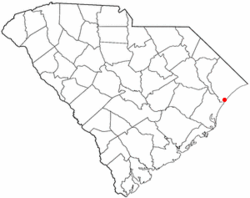Garden City, South Carolina | |
|---|---|
 The Pier at Garden City Beach | |
| Nickname: Garden City Beach | |
 Location in South Carolina | |
| Coordinates: 33°35′40″N79°00′05″W / 33.59444°N 79.00139°W [1] | |
| Country | United States |
| State | South Carolina |
| County | Horry, Georgetown |
| Area | |
• Total | 5.45 sq mi (14.12 km2) |
| • Land | 5.34 sq mi (13.84 km2) |
| • Water | 0.11 sq mi (0.28 km2) |
| Elevation | 20 ft (6.1 m) |
| Population | |
• Total | 10,235 |
| • Density | 1,914.9/sq mi (739.33/km2) |
| Time zone | UTC-5 (Eastern (EST)) |
| • Summer (DST) | UTC-4 (EDT) |
| ZIP code | 29576 |
| Area codes | 843, 854 |
| FIPS code | 45-28455 [4] |
| GNIS feature ID | 2402515 [1] |
Garden City, sometimes known as Garden City Beach, is a census-designated place (CDP) in Horry County, South Carolina, United States. The population was 9,209 at the 2010 census. [5] Garden City Beach is located directly south of Surfside Beach. The developed part of the beach extends south beyond the limits of the Garden City CDP, into Georgetown County, and ends on a peninsula at the mouth of Murrells Inlet. [6]

